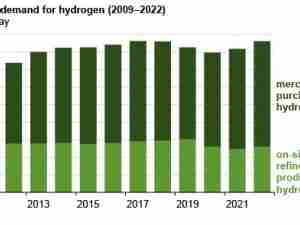Operational data has never been more critical for supply chain specialists to reduce emissions and implement greener practices. With global attention on environmental sustainability, there is increasing consumer demand for green products and services, putting additional pressure on organizations to deliver on sustainability.
Following the rise of recent political, social, and regulatory actions and mandates to reduce waste and environmental impact, global supply chains have come under greater scrutiny to measure and track the environmental impact of raw material sourcing, manufacturing processes, transport, and delivery.
In North America, the transportation sector has been identified as the single largest contributor of greenhouse gas emissions, at 28%. The logistics sector impacts nearly every other business and industry, by means of supplying essential goods, transporting raw materials, storing goods, and providing last-mile delivery.
Logistics software provider CartonCloud’s CEO Vincent Fletcher said for companies wishing to reduce emissions and meet their own carbon targets, they must be able to show full visibility across their entire supply chain — including each touchpoint from various logistics providers— which means entering the world of digitalization for many smaller providers.
“Pressure is building for all logistics providers to be able to track and provide data to partners, to ensure their footprint is measured,” Fletcher said.
“Having the ability to collect and provide data on an individual company’s practices — regardless of the size— is paramount to ensuring greater supply chain visibility and measurable metrics for change.”
Global Focus on Sustainability Metrics
With recent UN pressure for political and policy action, implementing environmentally friendly procedures has become front of mind for many companies and consumers. The Paris agreement created a major push for companies across all industries to look inside their own supply chains, causing a ripple effect for greener practices to be adopted down the line.
“While larger companies may look at undertaking massive overhauls of their operations to reduce emissions across a global network, for the smaller players handling one section of the greater supply chain, reducing environmental impact looks a little different,” Mr Fletcher said.
“That’s where we come in, our software gives smaller players the ability to easily capture, track, and share data with partners, to not only provide visibility on their operations — but also to optimize what they can, reduce waste, and establish scalable processes.
“With cloud-based software, smaller businesses can easily track and record data that can be used to identify areas to reduce carbon footprint across the last mile; including reducing wasted transport mileage with route optimization, cross docking or batch delivery for more efficient deliveries, and picking accuracy to reduce returns, fuel usage, and electricity.”
Supply Chain Visibility is a Global Action
Greener practices can not only help provide supply chain visibility for your customers (and help the planet), it can also help you to win business with those looking for greener or more environmentally friendly providers.
For small and medium-sized logistics businesses looking to track operations and reduce emissions, implementing a cloud-based warehouse and transport management system is the first step in reducing waste and having the data they need to identify ways to reduce their environmental impact.
There are many ways software-driven efficiency can help to optimize operations, including automating workflows, help to boost efficiency, and let companies achieve higher output with the resources they have. For smaller operators, cloud-based systems like CartonCloud can offer automation and software-driven efficiency that is tailored to their business, helping to reduce costs, overheads, and resource wastage across the board.
Fletcher said there were a number of quick wins companies could implement to boost efficiencies in their operations and reduce waste.
“Reducing waste is great for your business in general. You’ll not only have the ability to achieve greater output with the same resources, but you can also save money, and even win new business by showing your commitment to greener practices,” Mr Fletcher said.
“One fairly obvious solution is to reduce packaging waste and wasted fuel miles. Reducing both plastic waste and vehicle emissions makes a huge impact on the environmental impact of your business. However, it goes further than simply using environmentally friendly packaging. Reducing waste is about optimizing what you do to be more efficient, have fewer mistakes that need redoing, and identifying ways to use your current resources to do more.
“We’ve designed our software to allow smaller players to achieve incredible accuracy in data capture and stock selection— and to allow them to plan more efficient use of their resources with wave picking for warehouse, cross docking for more efficient transport, and route optimization”
Wasted delivery miles are an easy starting point for the industry, reducing emissions and also saving the company time and money. Automated software features like route optimization, batching, and cross-docking for efficient consignment planning, means companies can save fuel and reduce emissions. In fact, Bringg’s State of Last Mile Logistics Report found that by batching goods together for joint delivery to a local area, companies could reduce a company’s emissions by 59%.
A cloud-based solution not only optimizes operations to reduce waste, but also allows companies to track fuel usage, miles, storage, and other data, to look at carbon offsetting their usage.
Planning for Long-term Carbon Reductions
Not all change can happen overnight. Many companies are setting long-term targets to guide their operations and decision-making over the next few years, in order to meet their carbon emission reduction targets; such as using solar or wind power for lighting or shifting your fleet to green fuels, hybrid and electric vehicles where possible.
“There are a lot of renewable energy solutions out there that can be tailored to help you reduce your carbon footprint, and in some cases to save on overheads as well,” Mr Fletcher said.
“Once you have the initial set up covered, renewable energy solutions can be a more sustainable business solution into the future as well. For instance, refrigerated storage facilities might add solar panels to the roof, to start generating some of their own electricity. The same could be done for fleets with hybrid or electric vehicles.
“Companies can also look to offer reductions for their customers across other areas of the supply chain. For instance, offering multiple warehouse locations for micro fulfillment allows your customers to move their goods closer to the end consumers in more efficient, bulk orders, to reduce last-mile movement per order.
“Understanding how to better utilize your existing footprint with new services can also have a significant reduction in overall supply chain emissions. One example is; offering cross-docking and warehousing services alongside your existing operations so that goods can be processed in the system faster, with less handling, and less transportation between touchpoints.”
Companies like CartonCloud are providing mission-critical software to small and medium-sized logistics companies, to support them to seamlessly take their business and operations online; optimize workflows, reduce wastage, and increase their order fulfillment with the resources they have.








